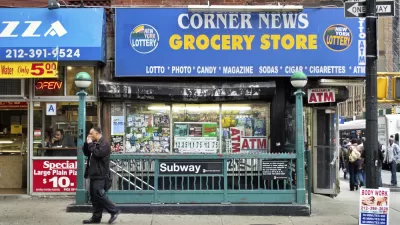How enforcing one federal law, ignored since the 1980s, could bring back small grocers and ensure more people have convenient access to fresh foods.

In a piece for The Atlantic, Stacy Mitchell explains the rise of “food deserts” — communities with limited or non-existent access to fresh food options — in the late 1980s as a result of a federal policy change.
“Food deserts are not an inevitable consequence of poverty or low population density, and they didn’t materialize around the country for no reason,” Mitchell writes. They occurred because the Reagan administration stopped enforcing the 1936 Robinson-Patman Act, allowing large grocery retailers to strong-arm suppliers and centralize their national purchasing power, pricing small retailers out of the market.
This led to a “massive die-off” of independent stores, Mitchell explains, and not just in the grocery sector: “From 1982 to 2017, the market share of independent retailers shrank from 53 percent to 22 percent.”
For Mitchell, “If you were to plot the end of Robinson-Patman enforcement and the subsequent restructuring of the retail industry on a timeline, it would closely parallel the emergence and spread of food deserts.” Small stores couldn’t keep up with product prices, and their customers couldn’t afford to pay more. “But once the independent stores closed, the chains no longer had to invest in low-income areas. They could count on people to schlep across town to their other locations.”
Mitchell asserts that enforcing the Robinson-Patman Act again is the key to eliminating food deserts and ensuring that all Americans have convenient access to fresh foods in their communities.
FULL STORY: The Great Grocery Squeeze

Alabama: Trump Terminates Settlements for Black Communities Harmed By Raw Sewage
Trump deemed the landmark civil rights agreement “illegal DEI and environmental justice policy.”

Study: Maui’s Plan to Convert Vacation Rentals to Long-Term Housing Could Cause Nearly $1 Billion Economic Loss
The plan would reduce visitor accommodation by 25% resulting in 1,900 jobs lost.

Why Should We Subsidize Public Transportation?
Many public transit agencies face financial stress due to rising costs, declining fare revenue, and declining subsidies. Transit advocates must provide a strong business case for increasing public transit funding.

Paris Bike Boom Leads to Steep Drop in Air Pollution
The French city’s air quality has improved dramatically in the past 20 years, coinciding with a growth in cycling.

Why Housing Costs More to Build in California Than in Texas
Hard costs like labor and materials combined with ‘soft’ costs such as permitting make building in the San Francisco Bay Area almost three times as costly as in Texas cities.

San Diego County Sees a Rise in Urban Coyotes
San Diego County experiences a rise in urban coyotes, as sightings become prevalent throughout its urban neighbourhoods and surrounding areas.
Urban Design for Planners 1: Software Tools
This six-course series explores essential urban design concepts using open source software and equips planners with the tools they need to participate fully in the urban design process.
Planning for Universal Design
Learn the tools for implementing Universal Design in planning regulations.
Smith Gee Studio
Alamo Area Metropolitan Planning Organization
City of Santa Clarita
Institute for Housing and Urban Development Studies (IHS)
City of Grandview
Harvard GSD Executive Education
Toledo-Lucas County Plan Commissions
Salt Lake City
NYU Wagner Graduate School of Public Service





























